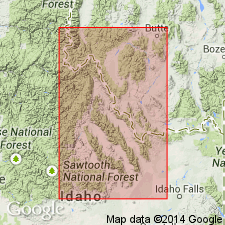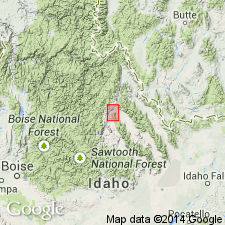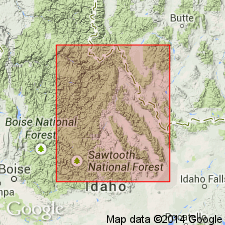
- Usage in publication:
-
- Big Creek Formation*
- Modifications:
-
- Named
- Dominant lithology:
-
- Quartzite
- AAPG geologic province:
-
- Northern Rocky Mountain region
Summary:
Named as a formation of the Lemhi Group (rank raised) for outcrops (type area) along upper reaches of Big Creek, south-central Patterson quad, T14N, R24E, Lemhi Co, ID in Northern Rocky Mountain region. Is one of the thickest and most widespread formations in the Lemhi Group. Crops out in central Lemhi Range near Patterson to Sawmill Canyon at head of Little Lost River, and in the Beaverhead Mountains. Is about 10,000 ft (3,100 m) thick. Is homogeneous--a light gray fine-grained feldspathic quartzite. Has layers of light- to green-gray, fine-grained feldspathic quartzite with abundant irregular fine-grained quartz sandstone cemented by ferrodolomite which, when weathered, gives quartzite a mottled look. Thin- to medium-bedded quartzite with scattered chips of gray argillite and siltite in upper 500 ft. Overlies West Fork Formation (new) of Lemhi gradationally. Underlies Apple Creek Formation (adopted) of Lemhi gradationally. Many beds are laminated and cross laminated. Magnetite grains commonly concentrated along the laminae. Is of Precambrian Y age.
Source: GNU records (USGS DDS-6; Denver GNULEX).

- Usage in publication:
-
- Big Creek Formation*
- Modifications:
-
- Age modified
- AAPG geologic province:
-
- Idaho Mountains province
Summary:
Age of the Big Creek Formation of the Lemhi Group is Middle Proterozoic Y [Middle Proterozoic].
Source: GNU records (USGS DDS-6; Menlo GNULEX).

- Usage in publication:
-
- Big Creek Formation
- Modifications:
-
- Revised
- AAPG geologic province:
-
- Northern Rocky Mountain region
Summary:
Revised in that it is gradationally below the newly named and designated as an informal term, the Hayden Creek diamictite beds of the Lemhi Group. Big Creek-Hayden Creek contact is gradational over 98 to 164 ft. Graded beds of diamictite are intercalated with Big Creek lithologies. Is 10,170 ft thick. Grain size of sandstone in Big Creek increases northward. Grain size plus sedimentary structures (asymmetric ripple marks, oscillation ripple marks, and soft sediment fold) suggest derivation from north of Hayden Creek area. Report area is in the vicinity of Hayden Creek, Lemhi Co, ID in the Northern Rocky Mountain region.
Source: GNU records (USGS DDS-6; Denver GNULEX).
For more information, please contact Nancy Stamm, Geologic Names Committee Secretary.
Asterisk (*) indicates published by U.S. Geological Survey authors.
"No current usage" (†) implies that a name has been abandoned or has fallen into disuse. Former usage and, if known, replacement name given in parentheses ( ).
Slash (/) indicates name conflicts with nomenclatural guidelines (CSN, 1933; ACSN, 1961, 1970; NACSN, 1983, 2005, 2021). May be explained within brackets ([ ]).

